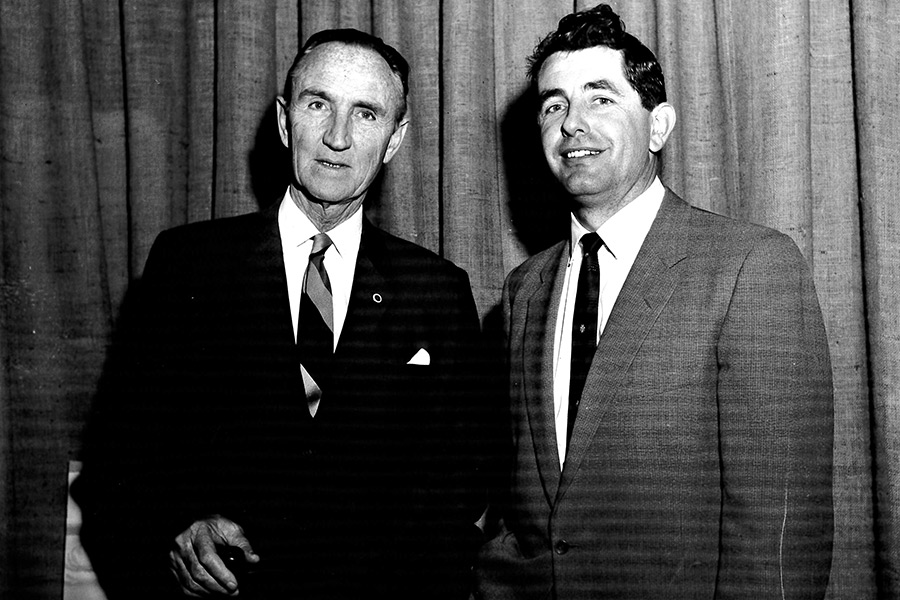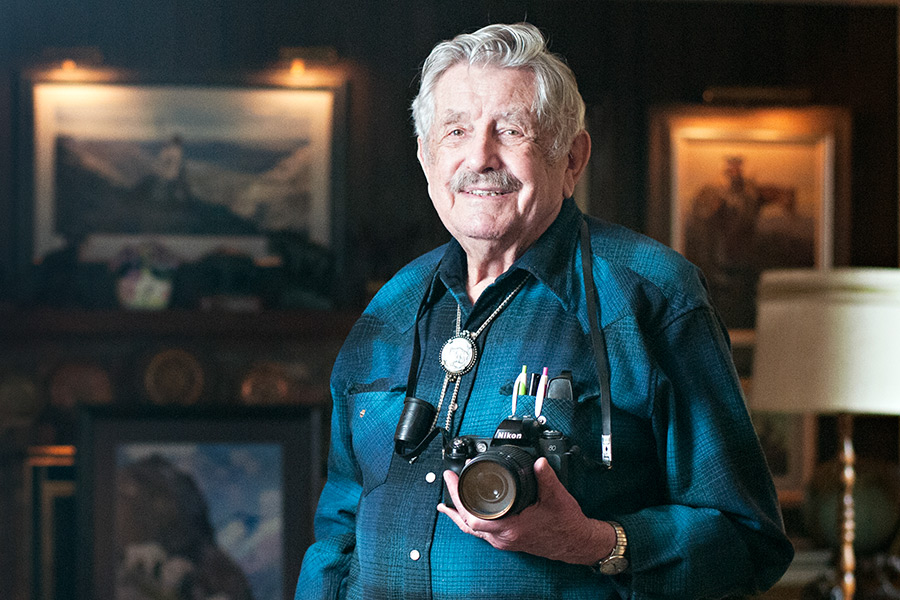There is a mighty tamarack — over 6 feet in diameter and almost the size of a small car, weighing at least 10,000 pounds — sprawled across the grass, right in front of him.
The man is sitting in the shade of the front-yard patio on a sunny afternoon, gazing out at this hunk of wood that has rested on his lawn for 40 years. Nowadays, the silver sheen of its bark resembles his mustache and fine-combed hair. Judging by the wrinkled rings at the butt of the log, it must be 500 years old, a remnant of a once-great presence from a bygone era, almost too extraordinary to be real.
Of course, there is quite the story behind that log. There are lots of stories.
When you have lived the life that G. George Ostrom has, there are bound to be a few tales.
“I’ve been blessed by the fact that, through fate and something within me, I’ve done so many very interesting things,” he says.
“I’ve lived kind of a wild life.”
Indeed. To hear him tell it, it would seem inconceivable, more fairy tales than fact.
Growing up on a ranch in Sanders County and then a mining camp near Kila in the heart of the Depression, “hauling every drip of water we used seven miles.” Traveling the new Going-to-the-Sun Road when it was barely a dirt pathway ascending Glacier National Park. Starting his first newspaper — the Hog Heaven Gazette — in sixth grade. Fibbing his age at 15 to get a job fighting wildfires in the rugged mountains of Northwest Montana. Skipping out of Flathead County High School at age 17 to train as a paratrooper in World War II. Sabotaging the Germans and guiding the Allied forces across Europe with a complex communication system he helped operate. Running to the top of the Eiffel Tower, and running away from cops chasing him for sitting on the railing of the Empire State Building. Diving out of airplanes as a squad leader in America’s first generation of smokejumping, and performing the lone jump at the dedication of the center in Missoula in 1954 in front of 40,000 people, including President Eisenhower.
And that was only during his first 20 or so years.
The endless stories are as legendary as the man, who is turning 87 on July 24 and is the inspiration for a new exhibit at The Museum at Central School in Kalispell. The exhibit debuts on Ostrom’s birthday with a public grand opening from 5 to 8 p.m.
The museum is showcasing a treasure trove of memorabilia from Ostrom’s life, evidence of his legendary adventures and exploits.
He has been celebrated many times before and is not one to shy away from the spotlight, although he has never asked for any of it, including this latest museum exhibit and the stack of awards he has accrued over the years.
“I’m not a guy who has a lot of trouble with his ego,” he says. “You’ve got to have self-confidence so you’re not daunted by things.”
The exhibit, which includes only a fraction of Ostrom’s collection, offers an exciting journey into the life of an icon and institution.
He has chronicled life in the Flathead Valley for over 60 years as a hall of fame radio broadcaster, award-winning columnist, photographer, newspaperman, television host, author and public speaker.
“George Ostrom is a legend in the Flathead, and for a good reason,” author Tom Lawrence wrote in his book, “Pictures, a Park, and a Pulitzer: Mel Ruder and the Hungry Horse News.”
Ostrom has motivated generations of explorers to travel out of bounds to the highest peaks and furthest vistas, on his own and as a member of the “Over-the-Hill Gang” alongside his best friend, Ivan O’Neil, and a group of hikers that for years has met once a week for adventures around the region.
“George Ostrom was one of my inspirations to start climbing in Glacier National Park. The tales and photos of his adventures in the high country spurred me to seek the summits,” said Blake Passmore, a noted local author and hiker who has published a series of hiking guides.
“Just his passion and knowledge of the outdoors and the park; if I could know a quarter of the stuff George does, that would be great.”
His love of the outdoors extended to the legislative realms, and he spent two years in Washington D.C. as an assistant for Montana U.S. Sen. Lee Metcalf, who spearheaded the Wilderness Bill, designating certain forests for permanent protection.
Another of his passions is education, though he never finished high school. He helped shape both the University of Montana and Flathead Valley Community College. After serving over 20 years as a member of UM’s President’s Citizen Council, he received the university’s Distinguished Alumni Award, though he never graduated. In Kalispell, Ostrom served on the first advisory board for FVCC and helped organize the newfound school in 1966 before later serving on the board of trustees. Four years ago, the college honored him with its Mentor Award, which recognizes a community leader whose leadership, vision and integrity inspire all.
“His vision of a local college in a community like the Flathead Valley has benefited women and men seeking to better their lives and has significantly impacted the economy in Northwest Montana,” FVCC President Jane Karas said at the time.
After helping the upstart KOFI radio station develop into a successful source of news, music and commentary, he bought the Kalispell Weekly News in 1974 and built it into the largest weekly in Montana with a circulation over 12,000 people.
For his civic work, including establishing the United Way and other community organizations, he has received the highest local honors, including Kalispell’s Great Chief Award, and the outspoken respect of former governors and sheriffs, including the late Jim Dupont, who wrote a letter of recommendation for Ostrom’s induction into the Montana Broadcasters Hall of Fame.
Ostrom’s influence and reputation have even stretched beyond this valley, demanding attention from Congressional lawmakers.
“Anyone who has come to know George Ostrom through his radio broadcasts, his photographs, his writing, or who has been fortunate enough as I have to spend time personally with him has come away with a better understanding of the American West and Montana in particular,” former Sen. Max Baucus said in a speech to Congress on July 22, 1998, to celebrate Ostrom’s 70th birthday.
For that memorable birthday, a grand party was held at the Outlaw Inn with a couple hundred people in attendance, including prominent community leaders and statewide dignitaries. Mike Mansfield, the famed U.S. senator from Montana and the nation’s longest serving Senate Majority Leader, even passed along a letter wishing Ostrom a happy birthday.
“He’s had a remarkable life,” Brian Kennedy, who owned the Hungry Horse News from 1978 to 1999, said. “All the stuff that he has seen in this valley alone, he could fill books with.”

Approaching 87, Ostrom is still at it. His column, marked by the familiar caricature drawn by artist Frank Hagel, still appears weekly in the Hungry Horse News. These witty, oftentimes humorous but sometimes serious pieces have appeared in the newspaper founded by Mel Ruder since 1962, when Ostrom was working for Metcalf. Ruder enjoyed Ostrom’s perspective and style and talked him into writing a “Hello Hungry Horse” column. His columns went on to win state and national awards.
He still can be heard on the airwaves, appearing regularly on KGEZ’s morning show, spinning tale after tale that proves he still has the gift of gab.
But these days, sitting in his home or on his front porch, he finds himself appraising his life more and more. How does a man measure himself? What’s his legacy? What are his greatest accomplishments?
Ask Ostrom, and most of what he wants to talk about is not himself.
“My greatest accomplishment, what I’m proudest of, is my family,” he says.
“That’s the thing that means the most to me.”
He can still recite the very moment he met his wife, Iris. He knows the exact date of their first date – April 23, 1957. A year later, on April 12, they were married and still are 57 years later.
“That’s the smartest thing I ever did,” he says.
He can’t talk enough about his two daughters — Wendy and Heidi — and two sons — Shannon and Clark. Flip through any of his books, and the pictures are mostly of his family and friends, the true focal point of his attention in front of grand sceneries and spectacular vistas.
Now his grandchildren are the ones he mostly wants to talk about, of them adventuring in Glacier Park, which he introduced them to, and swimming in Iceberg Lake or fighting wildfires, like he once did.
“I don’t know if it’s hereditary,” he says. “I don’t know. But that can get in your blood.”
Sitting on his front porch, or inside his Kalispell home, he tells all types of stories — funny, happy, tragic. The stories can follow a roundabout path and seem lost, but they always end up connecting together like pieces of a puzzle. And the puzzle eventually reveals a stunning portrait.
Now about that log.
